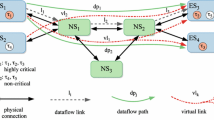Abstract
FlexRay is a communication protocol heavily promoted on the market by a large group of car manufacturers and automotive electronics suppliers. However, before it can be successfully used for safety-critical applications that require predictability, timing analysis techniques are necessary for providing bounds for the message communication times. In this paper, we propose techniques for determining the timing properties of messages transmitted in both the static and the dynamic segments of a FlexRay communication cycle. The analysis techniques for messages are integrated in the context of a holistic schedulability analysis that computes the worst-case response times of all the tasks and messages in the system. We have evaluated the proposed analysis techniques using extensive experiments. We also present and evaluate three optimisation algorithms that can be used to improve the schedulability of a system that uses FlexRay.
Similar content being viewed by others
References
Agrawal G, Chen B, Zhao W, Davari S (1994) Guaranteeing synchronous message deadlines with the token medium access control protocol. IEEE Trans Comput 43(3):327–339
Berwanger J, Peller M, Griessbach R (2000) A new high performance data bus system for safety-related applications. http://www.byteflight.de
R Bosch GmbH (1991) CAN Specification Version 2.0
Cena G, Valenzano A (2004) Performance analysis of Byteflight networks. In: Proceedings of the IEEE International Workshop on Factory Communication Systems, pp 157–166
Coffman EG Jr, Graham RL (1972) Optimal scheduling for two processor systems. Acta Inform 1:200–203
Ding S, Murakami N, Tomiyama H, Takada H (2005) A GA-based scheduling method for FlexRay systems. In: Proceedings of EMSOFT
Labbe M, Laporte G, Martello S (1995) An exact algorithm for the dual bin packing problem. Oper Res Lett 17:9–18
Echelon (2005) LonWorks: The LonTalk protocol specification. http://www.echelon.com
Ermedahl H, Hansson H, Sjödin M (1997) Response-time guarantees in ATM networks. In: Proceedings of the IEEE Real-Time Systems Symposium, pp 274–284
FlexRay homepage (2005) http://www.flexray-group.com
Hamann A, Ernst R (2005) TDMA time slot and turn optimization with evolutionary search techniques. In: Proceedings of the Design, Automation and Test in Europe Conference, vol 1, pp 312–317
Hoyme K, Driscoll K (1992) SAFEbus. IEEE Aerosp Electron Syst Mag 8(3):34–39
International Organization for Standardization (2002) Road vehicles-Controller Area Network (CAN)—Part 4: Time-triggered communication. ISO/DIS 11898–4
Kirkpatrick S, Gelatt CD, Vecchi MP (1983) Optimisation by simulated annealing. Science 220:671–680
Kopetz H, Bauer G (2003) The time-triggered architecture. Proc IEEE 91(1):112–126
Local Interconnect Network Protocol Specification (2005). http://www.lin-subbus.org
Miner PS (2000) Analysis of the SPIDER fault-tolerance protocols. In: Proceedings of the 5th NASA Langley Formal Methods Workshop
Navet N, Song Y, Simont-Lion F, Wilwert C (2005) Trends in automotive communication systems. Proc IEEE 93(6):1204–1223
Palencia JC, Gonzaléz Harbour M (1998) Schedulability analysis for tasks with static and dynamic offsets. In: Proceedings of the Real-Time Systems Symposium, pp 26–38
Pop P, Eles P, Peng Z, Doboli A (2000) Scheduling with bus access optimization for distributed embedded systems. IEEE Trans VLSI Syst 8(5):472–491
Pop T, Eles P, Peng Z (2003) Schedulability analysis for distributed heterogeneous time event-triggered real-time systems. In: Proceedings of the 15th Euromicro Conference on Real-Time Systems (ECRTS 2003), pp 257–266
Pop P, Eles P, Peng Z (2004) Schedulability-driven communication synthesis for time-triggered embedded systems. Real-Time Syst J 24:297–325
Pop P, Eles P, Peng Z (2005a) Schedulability-driven frame packing for multi-cluster distributed embedded systems. ACM Trans Embed Comput Syst 4(1):112–140
Pop T, Pop P, Eles P, Peng Z (2005b) Optimization of hierarchically scheduled heterogeneous embedded systems. In: Proceedings of 11th IEEE International Conference on Embedded and Real-Time Computing Systems and Applications, pp 67–71
Profibus International (2005) PROFIBUS DP Specification. http://www.profibus.com
Rushby J (2001) Bus architectures for safety-critical embedded systems. Lecture notes in computer science, vol 2211. Springer, Berlin, pp 306–323
SAE Vehicle Network for Multiplexing and Data Communications Standards Committee (1994) SAE J1850 Standard
Strosnider JK, Marchok TE (1989) Responsive, deterministic IEEE 802 5 token ring scheduling. J Real-Time Syst 1(2):133–158
Tindell K, Clark J (1994) Holistic schedulability analysis for distributed hard real-time systems, Microprocess. Microprogram. 50(2–3)
Tindell K, Burns A, Wellings A (1995) Calculating CAN message response times. Control Eng Pract 3(8):1163–1169
Author information
Authors and Affiliations
Corresponding author
Rights and permissions
About this article
Cite this article
Pop, T., Pop, P., Eles, P. et al. Timing analysis of the FlexRay communication protocol. Real-Time Syst 39, 205–235 (2008). https://doi.org/10.1007/s11241-007-9040-3
Published:
Issue Date:
DOI: https://doi.org/10.1007/s11241-007-9040-3




